The history of the
county, though interesting, has not been much concerned with the great
events of national history. And yet the existence in early days of a
royal residence at Kincardine indicates a certain importance. Kincardine
was probably chosen as a residence by the Pictish kings, because it
commanded the pass of the Mounth and the road to the eastward. Its
castle may have dated from the reign of William the Lyon. In mediaeval
times it was one of the chain of strongholds guarding the route from
Forfarshire over the Mounth to the north—Brechin, Kincardine, Loch
Kinnord, Kildrummy, Strathbogie, Rothes, Elgin, Duffus, Blervie,
Inverness, Dunskaith. As a royal residence, it grew less important when
the midland centres increased in power and influence, and it ceased to
he the capital of the shire in 1600, when Stonehaven became the chief
seat of local administration.
That the Roman legions under Severus (a.d. 208) passed through the
county is undoubted, though the events connected with this invasion are
obscure and disputed. Goaded into revenge by the insurrections of the
wild Caledonians, he set out himself with a strong force, and at once
began the formation or the continuation of the road through the
north-eastern lowlands. The route of the Roman armies through Strathmore
and the Mearns is clearly mapped out in the sites of the camps which run
in a line from Tay to Dee. These were at intervals of about 12 miles, or
a day’s march; and it is reasonable to assume that of the 50,000
soldiers lost by the Emperor in his Caledonian campaign, a certain
proportion must have fallen in the conflict with the sturdy " Men of the
Mearns.” The Roman camps in the county are said to have been at Fordoun,
and Raedykes, near Stonehaven, while Normandykes, in Peterculter, is
just beyond the county border. This view, strongly held by some
authorities, is strongly condemned by others. The battle of the camps
will have to be decided, if that is now possible, by excavations on the
sites. It is noteworthy that, in the Raedykes-Normandykes area, Roman
relics have been unearthed—coins, swords, pots.
In the wild days when Scotland was in the making, when Piets and Scots,
Angles of Lothian and Britons of Strathclyde, struggled for mastery, the
Mearns on the route from Fife and Perth to Aberdeen and Moray must have
been the scene of many a bloody conflict. After the union of Piets and
Scots, Kenneth MacAlpin’s immediate successors found the Mearns a
constant source of trouble: it was there that three kings died a violent
death. In 954, Malcolm I. was defeated and slain at Fetteresso, though
some say he was killed in Morayland. Forty years later Kenneth III.
incurred the enmity of Finella, wife of the Mormaer of the Mearns, whose
son had died in battle against the king. By her contrivance Kenneth was
killed, but how is not certain. Hector Boece’s account is grimly
picturesque. Kenneth had visited Finella’s castle at Fettercairn and was
conducted into a tower, “ quhilk,” to use the words of
Bellenden’s Scots version of Boece, “was theiket with copper, and hewn
with mani subtle mouldry of sundry flowers and imageries, the work so
curious that it exceeded all the stuff thereof.” There stood a statue of
the king, in his hand a gem-studded apple of gold. The apple (so Kenneth
was told) was a gift for himself. Would he deign to accept it from the
hand of the image? He touched the apple, and at once a shower of arrows
pierced his body. In 1094, when rivals claimed Malcolm Canmore’s throne,
the Mormaer of the Mearns, Malpeder MacLoen, backed Donald Bane against
Duncan II. In a battle at Mondynes in Fordoun parish, Duncan died. A
great stone on a knoll in a field, called Duncan’s Shade, is believed to
commemorate the spot.
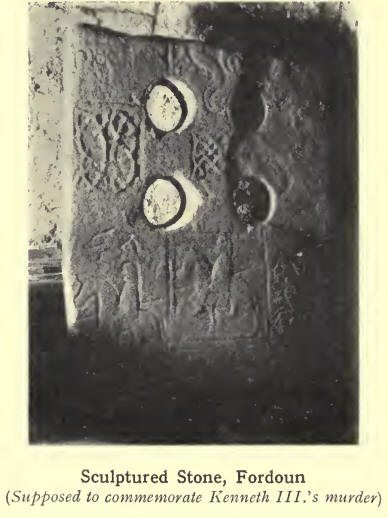
In common with the other
parts of the east coast, Kincardineshire suffered from the inroads of
the Danes during the tenth and the early part of the eleventh century.
At the battle' of Barry, their leader, it is said, was killed by the
founder Qf the Keith family, and was buried at Commieston in St Cyrus.
During the period of the Wars of Independence Edward I. passed through
the Mearns on his triumphal march northwards (1296). From Montrose he
directed his course to “ Kincardine in Mearns Manor,” then to Glenbervie
Castle, where he stayed a night, next over the Cairn O’ Mount to “
Durris manor among the mountains.” According to Blind Harry, Wallace
overran the Mearns in the following year, and penned 4000 Englishmen
within Dunnottar.
“Wallace in fyr gert set all haistely,
Brynt \vp the kyrk, and all that was tharin,
Atour the roch the laiff ran with gret dyn.
Sum hang on craggis rycht dulfully to de,
Sum lap, sum fell, sum floteryt in the se.
Na Sotherouu on lyff was lewyt in that hauld,
And thaim within thai brynt in powdir cauld.”
In 1562 the battle of Corrichie was fought on the south-east slope of
the Hill of Fare. Queen Mary was making a progress through the northern
shires when the Earl of Huntly turned rebellious. The royal forces,
under the Earl of Moray, defeated the rebels at Corrichie. From a spot
still named the Queen’s Chair, tradition says Mary viewed the fight.
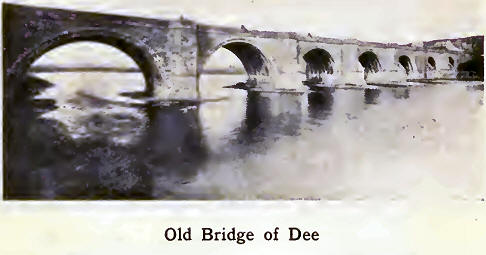
In 1639 the Marquis of
Montrose and his men passed through the county on their way to Aberdeen
to compel the people of Aberdeen to sign the Covenant. The Earl
Marischal and other “Men of the Mearns” joined him. During the
operations round Aberdeen occurred the “Raid of Stanehyve.” Viscount
Ab'oyne crossed the Dee with 2500 men, plundered Muchalls and had
reached Megray Hill, close to Stonehaven, when their opponents met them,
well supplied with cannon from Dunnottar. Highlanders feared “the
musket’s mother,” as they designated the cannon; and those in Aboyne’s
army fled when the cannonade began. Aboyne retired on Aberdeen, blocking
the only approach to the city— the narrow Bridge of Dee—with turf and
stones. The defences were forced and Montrose captured Aberdeen. In
1644, after he had turned Royalist, he was again in the Mearns, marching
from his victory at Tippermuir. Crossing the Dee at Mills of Drum, he
took Aberdeen. A year later he returned and burned the House of Durris.
At Stonehaven he did fearful havoc both by fire and sword, devastating
houses, farms, and woods so that “ the hart, the hind, the deer, and the
roe skirlt at the sicht of the fire,” whatever may have been the
feelings of the sorely stricken inhabitants. Finding that the Earl and
others had secured themselves in Dunnottar Castle, he pillaged and
burned the village of Cowie, with the boats and stores, and all the
lands of Dunnottar, Fetteresso, Glenbervie, and Arbuthnott. Marching
along, he routed a party of the Covenanters at Haulkerton near
Laurencekirk, and made the Howe “black with fire and red with blood.”
His last progress through the Mearns was in 1650, when as a prisoner,
bound hand and foot, he was led to his execution in Edinburgh.
After Charles ll.’s coronation at Scone, January 1, 1651, the “ honours
” of Scotland—the crown, the sword, the sceptre—had been deposited in
Dunnottar. Dunnottar was the last stronghold to yield to Cromwell’s
troops. It was invested in the late autumn of 1651. The English general
knew that the Regalia had been taken into the castle, while George
Ogilvie of Barras, the governor, doubted if he could hold out with his
meagre garrison, especially as food was scanty and mutiny was appearing
among the men. At this crisis Mrs Granger, wife of the minister of
Kinneff, obtained permission to visit Mrs Ogilvy. A scheme was devised
to save the Regalia. When Mrs Granger left, she had the crown concealed
in her lap; and her serving-woman carried the sceptre and the sword in
bundles of flax. A touch of irony is added to the incident in the
tradition that the English general himself gallantly assisted Mrs
Granger to her horse. In a short time the Regalia lay, carefully wrapped
up, under the floor of Kinneff church. There they remained till after
the Restoration.
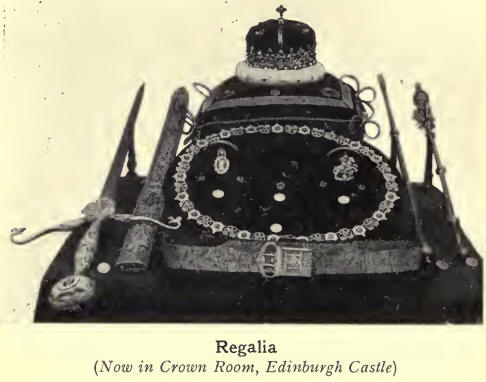
In 1685, during the scare
of Argyll’s invasion, over a hundred Covenanters from the south-west of
Scotland were imprisoned in Dunnottar. Men and women were shut up in a
vault too small for them either to lie or sit. It had but one window,
and the floor was ankle-deep in mud. After some time, the men and the
women were separated, and several vaults were used instead of one.
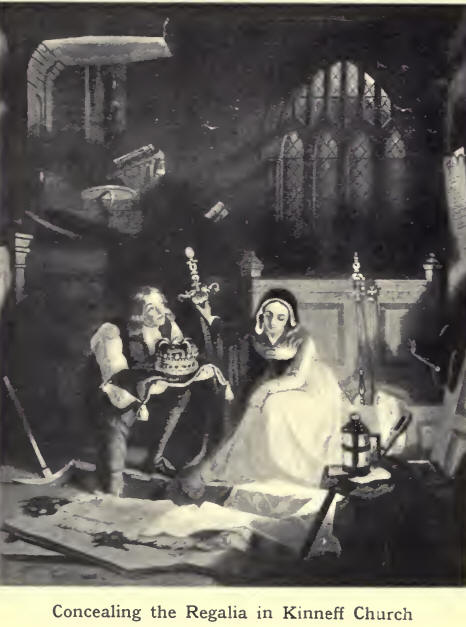
From the window of the
large vault twenty-five tried to escape down the steep cliff. Two were
killed ; a few eluded capture ; those who were unsuccessful were bound
and laid on their backs for several hours with burning matches between
their fingers. After two months the survivors were conveyed to Leith,
where they could choose either to take the Test Act or be banished to
the Plantations. Most elected to go into exile.
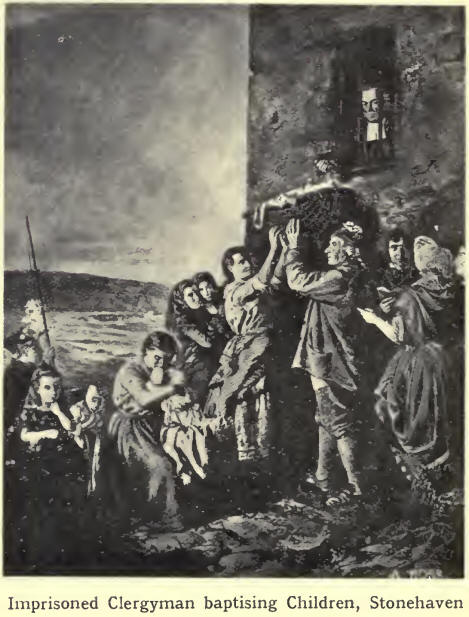
Like the north-east of
Scotland generally, the north of Kincardineshire was strongly Jacobite,
due to the influence of the Earl Marischal.- In 1715, when, the
Chevalier de St George—the Old Pretender—was passing south from
Peterhead to join his followers, he visited Fetteresso, where he was
proclaimed king. In 1746, when the Duke of Cumberland was marching to
Aberdeen, ultimately to meet the Young Pretender at Culloden, he burned
the Episcopal chapels at Stonehaven, Drumlithie, and Muchalls. The
Episcopal clergy, as favouring the Stewarts, were frequently “rabbled”
at this time, and some of them imprisoned.
|

